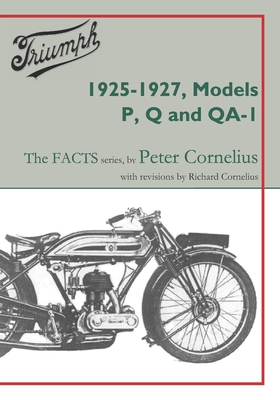Triumph 1925-1927, Models P, Q and QA-1

Triumph 1925-1927, Models P, Q and QA-1
Triumph Models P, Q and QA-1The Model P is probably the best known Triumph of the vintage period. With almost 50,000 made, and sales round the world it is one of the most numerous Triumphs still surviving a century later. Spares are fairly easy to come by and as a 'no frills' machine what is not found at swap meets is not difficult to reproduce. The Model P was followed by two Sports versions, the Model Q and an overseas Super Sports Model QA.
There was also later, a 1927 Model QA. This was different to the 1926 model, being closer to the 1927 Model N; hence my 'QA-1' in the booklet title. References in this booklet to the Model QA will relate only to the 1926 Model. Much has been written of the Model P in books and magazines. Some is true, some is fiction and some is very inaccurate. It seems that while there may be many who write, it appears that few are historians.
In one book, one reads that the Model P "was a disaster for Triumph". However nothing could be further from the truth for the Model P was Triumph's saviour at a time when they, like most of the motor cycle manufacturers, were in financial trouble - the mid-1920s, due to the post-war boom having fizzled out, castings strikes stifling production, plus not least of all, the fact that the Austin Seven car was available for around 25 more than a motor cycle and sidecar and in 1924 more cars were registered in Britain than motor cycles. Triumph's profit had fallen dramatically for 1924. Triumph decided that the way out of the industry's recession was to work, and sell, their way out in a similar manner to when Herbert Austin had previously dropped the intended price of the Austin Seven from 225 to 165, causing them to sell like hot cakes. So Triumph needed a new machine with a rock bottom price.
Thus was born the idea of a 'lightweight' 500cc model capable of solo use, yet with power to haul a sidecar with ease, and capable of easily being modified to provide a 'sports' version for those who desired such a machine. Without frills the Model P was not only lightweight, but also capable of being assembled easily and quickly, so plans were made for the Works to be able to produce a large number of machines in a relatively short space of time. ---------- The early decades of the 20th century was an exciting period of innovation in automotive history when travel options were limited and the freedom of motorcycling was a real adventure.Are you are restoring one of these early Triumph motor
168.41Lei
168.41Lei
Indisponibil
Descrierea produsului
Triumph Models P, Q and QA-1The Model P is probably the best known Triumph of the vintage period. With almost 50,000 made, and sales round the world it is one of the most numerous Triumphs still surviving a century later. Spares are fairly easy to come by and as a 'no frills' machine what is not found at swap meets is not difficult to reproduce. The Model P was followed by two Sports versions, the Model Q and an overseas Super Sports Model QA.
There was also later, a 1927 Model QA. This was different to the 1926 model, being closer to the 1927 Model N; hence my 'QA-1' in the booklet title. References in this booklet to the Model QA will relate only to the 1926 Model. Much has been written of the Model P in books and magazines. Some is true, some is fiction and some is very inaccurate. It seems that while there may be many who write, it appears that few are historians.
In one book, one reads that the Model P "was a disaster for Triumph". However nothing could be further from the truth for the Model P was Triumph's saviour at a time when they, like most of the motor cycle manufacturers, were in financial trouble - the mid-1920s, due to the post-war boom having fizzled out, castings strikes stifling production, plus not least of all, the fact that the Austin Seven car was available for around 25 more than a motor cycle and sidecar and in 1924 more cars were registered in Britain than motor cycles. Triumph's profit had fallen dramatically for 1924. Triumph decided that the way out of the industry's recession was to work, and sell, their way out in a similar manner to when Herbert Austin had previously dropped the intended price of the Austin Seven from 225 to 165, causing them to sell like hot cakes. So Triumph needed a new machine with a rock bottom price.
Thus was born the idea of a 'lightweight' 500cc model capable of solo use, yet with power to haul a sidecar with ease, and capable of easily being modified to provide a 'sports' version for those who desired such a machine. Without frills the Model P was not only lightweight, but also capable of being assembled easily and quickly, so plans were made for the Works to be able to produce a large number of machines in a relatively short space of time. ---------- The early decades of the 20th century was an exciting period of innovation in automotive history when travel options were limited and the freedom of motorcycling was a real adventure.Are you are restoring one of these early Triumph motor
Detaliile produsului










